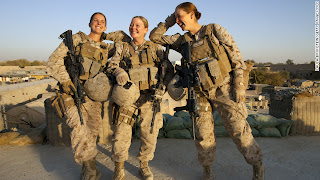Author: Chelsea J. Carter and Steve Almasy, CNN
Reposted from: cnn.com
In this article, the Department of Defense is expected make a change in its policy to allow women to participate in combat.
CNN) -- For women who have already seen combat, it is a decision that is well overdue. But for the skeptics, it is a setback that will damage the military.
The Pentagon's reported decision to lift the ban on women in combat units will take time to put into effect, but many former service members are lauding reports the Defense Department will make the change soon.
"We have an all-volunteer force, and I think that this opens up a pool of folks who could serve in these positions," said Rep. Tammy Duckworth, an Iraq War veteran who lost both legs and the use of one arm when her helicopter crew was shot down in 2004. "Any time that we've opened up our military to performance-based service ... we've benefited as a military. This is good for the nation."
The new policy will be implemented over the next three years and some units may apply for exemption, a senior defense official told CNN.
Duckworth, an Illinois Democrat, said the military should open up every unit to women and see if they can complete the required training.
"If the women can't meet the standards, they don't get to graduate from the program."
Julie Weckerlein, who served 9 1/2 years in the Air Force and did tours in Iraq and Afghanistan, thinks the change reflects the military catching up with the times.
Some women have already gone on patrols with ground troops, helping to talk with female civilians in Afghanistan. Some submarine crews have added female officers. Women also serve as military police officers.
Women supporting supply missions have been drawn into battle in Iraq and Afghanistan, where there are no physical front lines.
Now, Weckerlein said, "people will be able to serve in the career fields they are qualified for, and that they won't be turned away because of their gender."
Weckerlein went to Iraq in May 2007 as part of then-President George W. Bush's "surge policy" to put more troops on the ground.
"The first death I experienced was a woman, within the first few weeks I was in Iraq," she said.
It was June 25, 2007, and she was at an outpost in Nasir Lafitah when it came under mortar fire. In the attack, Army Staff Sgt. Trista Moretti of South Plainfield, New Jersey, was killed. Moretti, 27, was assigned to a support battalion.
Days later, Weckerlein came under mortar fire again. This time, her comrade -- a cameraman -- was injured.
Even though her deployment orders said Qatar, she spent weeks the summer of 2007 shuttling between bases in Iraq and Afghanistan.
Like many women in the military, Weckerlein didn't get the additional combat training because she was in what was considered a support role.
"I really want to stress there was no bitterness. It was a reflection of the times, and I feel like we are now getting with the times," she said. "I see this as a positive thing."
Not everyone agrees.
Rep. Tom Cotton, an Arkansas Republican, has said he doesn't think women are physically capable of combat duty.
"To have women serving in infantry ... could impair the mission essential task of those units, and that's been proven in study after study," he told radio host Laura Ingraham earlier this month. "It's nature -- upper body strength and physical movements and speed and endurance and so forth."
Jonn Lilyea, one of the founders of the military blog "This Ain't Hell," wrote that he thought it was an "ill-considered decision."
Lilyea, a former sergeant who fought in Desert Storm, wrote he was opposed to women in combat units, not because women are a distraction but because he thinks the Army and other services will be required to accept more women than are qualified or can be trained.
"If we're doing this to make the military better, fine, but if we're doing it just to beat our collective chest and show how just we are, then that's how a lot of body bags are going to get filled," he wrote.
Kayla Williams, author of the memoir, "Love My Rifle More Than You: Young and Female in the U.S. Army," said she thought most of the enlisted men would accept women into combat units.
"They will do their jobs, they will be profession, perhaps a few will be disgruntled," she said. "Troops grumble, that's what we do, but many of them have already served along with women."
Williams, who saw combat while with the 101st Airborne, said she thought some branches of the military would ask for exceptions to the policy, and that was hard to argue with.
"Let's take this step and let women keep proving what they have already proved before," she said.
Sgt. 1st Class Stephanie Cazares with the 4th Brigade Combat Team, 1st Armored Division, at Fort Bliss, Texas, said it was impossible to know what, if any, changes it would mean for women in the military.
"It's not just put females in combat (specialities) and let's call it a day," she said.
A number of issues, including safety regulations and cohabitation, will need to be addressed, she said.
Army Staff Sgt. Stacey Zinda said that, like Cazares, she wasn't surprised by the news.
Troops have speculated about the issue for a while, but Zinda, who is a career counselor, said she has yet to have a female soldier approach her about joining a combat unit.
Frank Kearney, a former lieutenant general of the US Army, would like to hear your thoughts on this report. This Facebook page gives his perspective on women in combat.


















